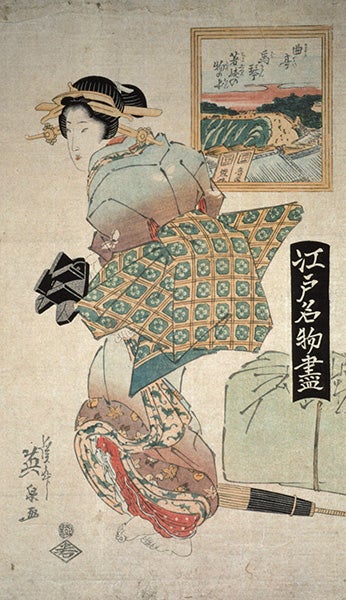Brandi Wilkens, an undergraduate student in the Department of the History of Art and Architecture, has been selected as one of six UO students to participate in the Humanities Undergraduate Research Fellowship for her research project, “Not Just a Pretty Face: 19th century Japanese Courtesans and their influence in art exportation.”
Wilkens is researching and writing a comprehensive paper on the topic during winter and spring 2016 terms, and will present her research at the 2016 UO Undergraduate Symposium on May 19.
In “Not Just a Pretty Face,” Wilkens is investigating the cross-cultural connections between Japan and Europe with an emphasis on France, a culture that harbored a particular affinity for all things Japanese during the 19th century. When Wilkens learned of the French term Japonisme, which refers to France’s adoration for Japanese culture, she recognized the research potential within this field.
Wilkens found that major studies of the Japanese influence on European art has traditionally been from either a European or a Japanese perspective, but she is trying to offer a more impartial view of the field that studies both cultures independently.
“It is my intention to approach this confluence from both sides. I feel that the surface has only begun to be scratched in this fascinating time period,” says Wilkens.
Courtesans were women who worked in the pleasure districts of metropolises like Nagasaki or Edo (modern-day Tokyo), about the only areas Europeans were allowed to visit in Japan at the time. The courtesans were muses for many ukiyo-e artists, a style typically illustrated in woodblock prints from the seventeenth through nineteenth centuries. Because European traders and merchants often visited these pleasure districts, Wilkens says it’s plausible that these women had a profound effect on Japanese art exportation to Europe.
Wilkens hopes during graduate school to parlay this study into further research about the confluence of Japanese and French culture. Next year, as a fifth-year senior she plans to study Japanese as well as enter her third year of studying French.
“It is the difficulty in learning both European and Asian languages that has prevented scholars from approaching this cross-culturation from both perspectives,” says Wilkens. “It is my goal to change that, although I do acknowledge the difficulties I face in doing so.”


Above left: Keisai Eisen (1790-1848), Books by Kyokutei Bakin (Kyokutei Bakin chojutsu no mono no hon), from the series Exhaustive List of Famous Things from Edo (Edo meibutsu zukushi). Japanese; Edo period, 1820s. Woodblock print in vertical ōban format; ink and color on paper, H. 15 x W. 8-5/8 inches. JSMA; JPN51.Ye1.1. Above right: Utagawa Yoshitora (fl. 1830s-1887), American Strolling and Drinking with Courtesan (Amerika-jin yūkō sakamori). Japanese; Edo period, 1861. Woodblock print in vertical ōban format; ink and color on paper, H. 14-3/4 x W. 10 1/8 inches. JSMA; Murry Warner Collection, MWJY51.Y41. Thanks to Akiko Walley for procuring images.
Akiko Walley, Maude I. Kerns Assistant Professor of Japanese Art in the Department of the History of Art and Architecture, is Wilkes’ project advisor for the Humanities Undergraduate Research Fellowship.
“Brandi is simply every art history professor’s dream student — perceptive, thoughtful, and genuinely excited about engaging with works of art,” says Walley.
Walley also served as Wilkes’ faculty advisor when she participated in the Wadsworth Research Internship program, which resulted in a Jordan Schnitzer Museum of Art exhibition called Expanding Frontiers: The Jack and Suzy Wadsworth Collection of Postwar Japanese Prints.
In this program, Wilkes researched Japanese mezzotint artist Hamanishi Katsunori.
“Brandi is a natural researcher,” says Walley. “In addition to being thoughtful and eloquent, she has a knack for identifying the most interesting avenue of research for any given topic, making her works always intellectually stimulating and a joy to read.”
After completing her bachelor’s degree, Wilkens hopes to enroll in graduate school at UO to study art history and complete a museum studies certificate.
Asked why she wants to stay in Eugene for graduate school, Wilkens can’t stop from gushing about the UO’s art history program.
“The coordinating efforts of the museum and art history department have really impressed me. The art history department works well with the museum, and some classes have us engage with the museum on an outstanding level,” she says. “Along with that, the art history faculty is really quite amazing. All my professors are very knowledgeable, genuinely seem to enjoy imparting that wisdom to their students, and are very available to students and want to help us succeed. Their enthusiasm spills over and is quite contagious. And there are always many exceedingly interesting classes to take. … The museum staff are quite amazing as well.”
The Humanities Undergraduate Research Fellowship is offered through a partnership between the Oregon Humanities Center, the Undergraduate Research Opportunity Program, the Office of the Vice President for Research and Innovation, and the Division of Undergraduate Studies.
